
Gobble gobble! Feast your eyes on the lineup for NNA2 #40, featuring a hearty helping of some of the best folks from Ann Arbor’s food scene. Joel Panozzo of The Lunch Room guides us through his approach to veganism, including his take on why tofu tastes bad. Ann Arbor Distilling Company’s Phil Attee gives us a glimpse into how booze is born, and walks us through a day in the life of a distiller. Last, but certainly not least, Mike White from Zingerman’s slices us off a hunk of some pungent, delectable cheese knowledge. So put on your elastic-waist pants and turkey-trot your way over to Live — and raise a glass with your fellow nerds!
When: Thursday, November 17, 2016, doors at 6:30 pm, talks at 7 pm!
Where: LIVE, 102 S First St, Ann Arbor
$$$: NO COVER, thanks to your friendly neighborhood AADL!

NNA2 edition #39 is coming at you in all its vaguely Halloween-y glory! Filmmaker Jen Proctor will explore the paranormal communication and hear voiiiiiices from beyond – or at least, what believers claim are voices from beyond. Sara Wedell, who has read Laura Ingalls Wilder’s Little House books more times than you have, will reveal the sinister side on the prairie – a family of serial killers preying on pioneers. And superHERoes Chelsea Liddy and Amanda Reyes Aquino of Comique Con will talk about the evolving roles of women in the world of comics. So put on your smarty-pants glasses and come on out to raise a few beer glasses!
When: Thursday, October 20, 2016, doors at 6:30 pm, talks at 7 pm!
Where: LIVE, 102 S First St, Ann Arbor
$$$: Free, thanks to your friendly neighborhood AADL!
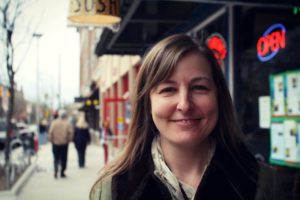
Jen Proctor: Talking to the Dead: A History of Spirit Communication Technologies – Jen Proctor
From the telegraph to mobile apps, from Poltergeist‘s televisual ghouls toUnfriended‘s possessed Skype sessions, from EVPs to spirit photography, this talk will explore the history of attempts to communicate with the dead using electric and electronic technologies. We’ll see and hear terrifying and not-so-terrifying evidence of spectral messages, and examine what exactly constitutes evidence for investigators of the paranormal. GHOSTLY CAT VIDEOS WILL BE INCLUDED!
About Jen: Proctor is a filmmaker, media artist, and Associate Professor of Journalism and Screen Studies at UM-Dearborn. She is currently working on a documentary about the relationship between technology, the paranormal, and spiritual belief. In her spare time, she studies abnormal feline behavior.
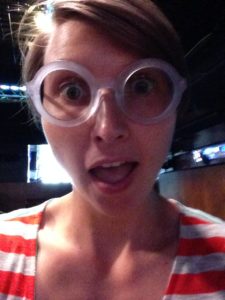
Sara Wedell: Little Slaughterhouse on the Prairie
Frontier life in the 1870s was hard and the massive prairie held endless dangers – aside from the harsh elements, the grueling work, and the salt pork-heavy diet. This is the sinister side of Little House on the Prairie – the true story of a family of serial killers targeting pioneers on their way out West.
About Sara: Sara Wedell is a production librarian at the Ann Arbor District Library and a Nerd Nite Ann Arbor Co-Boss. She knows it’s not cool to love Laura Ingalls Wilder, BUT SHE DOES IT ANYWAY. #sunbonnetsquad

Chelsea Liddy and Amanda Reyes Aquino: A History of Women in Comics
We’ll discuss how women’s roles in and in creating comic books have evolved over the past 100 or so years, as well as how things are changing and the future that Comique Con is helping to create.
About Chelsea, Amanda, and Comique Con: ComiqueCon is a one-day celebration of the contributions of women to the sequential arts. Launched in 2015 in Metro Detroit, the event brings together comics all-stars and their fans for a wicked awesome day of comics and cosplay! Prior year featured guests have included Alex de Campi, Mikki Kendall, Marguerite Sauvage, Carey Pietsch, Nancy A. Collins and Mairghread Scott. In an industry that consistently under-solicits women, we’re spotlighting the work of women in comics and encouraging representation and inclusiveness.
NNA2 ed
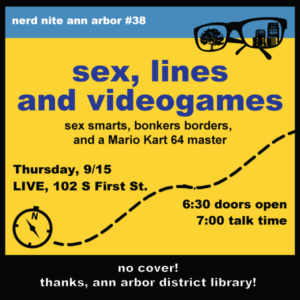
ition #38 is proud to present sex smarts, bonkers borders, and a Mario Kart 64 master this month for your learning-while-drinking pleasure. Master of Public Health and owner of the S3 Safe Sex Store Beth Karmeisool presents a pop quiz on sexual health – AND THERE WILL BE PRIZES. Geography buff Alex Stefanov outlines outrageous examples of where (and why) countries draw their lines, and speed-running world record holder Jonathan Serwatowski levels with us on how playing video games as fast as possible can make the world a better place. Bring your brain, your buddy, and your beer money, and join us for a great night of nerd-dom.
When: Thursday, September 15, 2016, doors at 6:30 pm, talks at 7 pm!
Where: LIVE, 102 S First St, Ann Arbor
$$$: Free, thanks to your friendly neighborhood AADL!
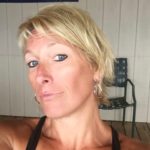
Beth Karmeisool: “S3 Safe Sex Store Trivia and Talk”
Pop quiz, hot shot! Bring your sexual health A game and we’ll see what you really know about sex. Be the first to answer correctly and win a sexy prize.
About Beth: Beth is the founder of S3 Safe Sex Store and has a Master’s of Public Health specializing in sexual health awareness and prevention of STDs and unintended pregnancies. She has been educating about and promoting sexual health to normalize sex for over 20 years.
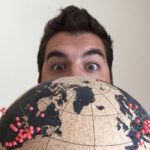 Alex Stefanov: “Bonkers Borders: Crazy Ex(clav)es, Drunken Surveyors, and Uzbeki Seas”
Alex Stefanov: “Bonkers Borders: Crazy Ex(clav)es, Drunken Surveyors, and Uzbeki Seas”
Borders are all around us, literally! These days, too many people struggle to place Poland on a map and even have trouble identifying West Virginia. If we paid more attention to our geopolitical frontiers, we’d find not only fascinating shapes but also rich histories behind them! Was moonshine consumption involved in delineating the Carolinas? Could poker have been a driving factor in demarcating India? Is there still unclaimed land out in the world? Let’s explore these and other intriguing cases of bonkers borders!
About Alex: Alex is a Michigan alum from New York and Bulgaria who loves the borders of all three. He looks to be a neuroscientist by day and a geography hobbyist by night, a sort of “Doctor With Borders”.
Jonathan Serwatowski: “The Insanity of Speed Running”
We’ll run down the basics of speed running: terminology, frame count, how to select your game, go in-depth on Mario Kart 64, demonstrate hand exercises for longevity, and a few funny speed run reaction videos. There’s also more to speed running than meets the eye, so we’ll also discuss the charity work opportunities the pastime presents.
About Jonathan: I am a recent graduate with a B.A. in History from Grand Valley State University. I am a speed runner with 3 years of speed running experience. I primarily run Unreal Tournament, Mario Kart 64, and Star Wars: Empire at War. I am the current world record holder in Star Wars: Empire at War in the Category of Zan Consortium Campaign Easy. I am the 17th in the world in Mario Kart 64, any %, no skips, and a former record holder of Mario Kart 64 100%. I also have the 4th best time in Unreal Tournament 1999 deathmatch %. Outside of gaming, my interests include current world events, heavy music, gardening, fishing, and tennis. Follow hum on Twitter @serwatoj.

This month, we have a diverse trio of great topics headed your way at NNA2 edition #37!
Aric Schultz returns to the NNA2 stage to give us the scientific skinny on genetically modified organisms. Beloved heckler Kevin Davis is back to talk data storage and perhaps ruin any illusions you may have regarding the cloud. And fellow NNA2 alum Carl Engelke (of the amazing homemade trumpet!) brings us home with his talk on the most epic magical saga of all time – Wagner’s Ring Cycle. Going to be a great night, so grab some friends and a couple of cold ones to join us at Nerd Nite!
When: Thursday, August 18, 2016, doors at 6:30 pm, talks at 7 pm!
Where: LIVE, 102 S First St, Ann Arbor
$$$: Free , thanks AADL!
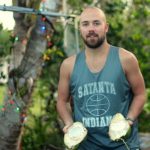
Aric J Schultz: “OMG, GMOs.”
We often hear the term “genetically modified organisms” (GMOs) without much context as to what they are and what they are not. I’ll explain how they are made, plus their application and impact.
About Aric: I am a graduate student in the microbiology department at the University of Michigan Medical School. I study a microscopic parasite, Toxoplasma gondii, in order to learn more about how it causes disease in humans and identify aspects of this infection that could be exploited and used in the treatment of the disease. Outside of the lab I enjoy practicing brazilian jiu jitsu, gardening, and of course science communication. Follow him on Twitter at @aricj10.
 Carl Engelke: “The use of leitmotif in Wagner’s Ring Cycle: A boring musicology talk”
Carl Engelke: “The use of leitmotif in Wagner’s Ring Cycle: A boring musicology talk”
The original “never-ending story,” (okay, so it’s actually 15 hours) Wagner’s epic opera cycle Der Ring des Niebelungen is widely regarded as the best way to thoroughly convince people that they hate opera. But it need not be so! As we cruise through a “brief” synopsis of the plot, we will explore how Wagner’s use of musical motifs neatly ties the storyline together, and how this compositional style has influenced the development of film scores.
About Carl: Carl had many, varied interests throughout the years, and he still sometimes wonders what he wants to do when (if) he grows up. He studied trumpet performance in college at Indiana University and the Royal Academy of Music in London, and performed with the Civic Orchestra of Chicago upon graduation. Currently, as a completely logical next step, he is an MD/PhD student at the University of Michigan Medical School, where he studies how chromatin dynamics influence the development and progression of prostate cancer.
Kevin Davis: “Flipping Bits: The History of Data Storage”
A review of the advancement of data storage and archival technologies, from the Mainframe to the Pokedex.
About Kevin: A SAN Engineer for a Fortune 10 company, Kevin determines the best IT storage solutions, for needs ranging from PowerPoint to Oracle. A 17-year IT veteran, he spends his days hard drive drag racing, writing manuals and procedure guides, reviewing new builds, and overseeing storage operations.

Summer’s here and the time is right for nerding out with friends! The 36th edition of NNA2 will be next Thursday, July 21! Up this month: a fantastic trio of full-spectrum talks by some of Ann Arbor’s greatest. Katie Prater will take us beyond The Game of Life to introduce us to the wide world of European board games. Lorraine Suzuki will explain what’s going on in your brain when you’re learning to ride a bike (and why that’s different than memorizing state capitals!). And Danny Mayer will show us how evolution shapes our lives by impacting culture as well as our genes. So grab a drink and a couple of pals to come beat the heat with your fellow nerds!
When: Thursday, July 21, 2016, doors at 6:30 pm, talks at 7 pm!
Where: LIVE, 102 S First St, Ann Arbor
$$$: Free because Ann Arbor District Library has got you covered!
Katie Prater: “The Death of The Die: The Rise of “Euro” board games in America”
Did you “Pass Go and Collect $200” on your way in to work today? If you grew up playing classic American board games as a child, you’re likely familiar with never-ending games of Monopoly or squabbling over some uninhabitable territory of Australia in Risk. But board games aren’t just for kids anymore! Adult nerds all over America are gaming, and loving it! We’ll discuss the characteristics of classic American games, the differences between those and Eurogames, and why everyone who tries them agrees that Eurogames are much more fun! If you’re interested in spending your nights and weekends breeding sheep, building temples, recycling garbage, and taking control of your own destiny, this talk will get you started!
>About Katie: When not in the neuroscience lab at UofM, Katie can often be found teaching new board games to friends, with her nose in a book, playing computer games with her husband, or enjoying the outdoors. She also loves attending GenCon, where she can check out the newest board games and show off her Kaylee Frye costume. She recently completed her PhD, during which she also co-founded a science communication organization called RELATE (www.learntoRELATE.org). Follow her on Twitter at @katieeprater.
Lorraine Suzuki: “Motor learning and memory systems”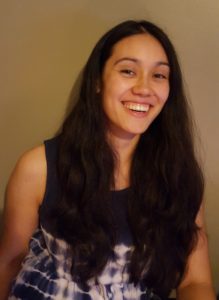
As we learn motor skills we use two memory systems. These systems are separate and can compete with each other. My talk will go over some evidence of this interaction within the brain.
About Lorraine: Lorraine is a PhD candidate in the School of Kinesiology at the University of Michigan. She obtained a Bachelor’s degree in Biology and a Master’s degree in Genetics from the University of Western Brittany (Universit de Bretagne Occidentale. She now works on understanding how learning new motor skills affects brain networks.
Danny Mayer: “Genes, Memes, and Human Beings: Why Evolution Isn’t Just a “Life” Thing”
Evolution is a part of our everyday lives. We might talk about how someone’s beliefs have evolved. We might explain the success of an app or business as “survival of the fittest.” But rarely do we consider that evolution—in the real, scientific sense—might be able to explain things other than life. Maybe life isn’t as special as we think—after all, viruses aren’t considered by science to be alive, and yet they evolve in more or less the same way that living cells do. Enter memetics: the study of how units of cultural information (memes) evolve. Using memetics, genetics, and philosophical theories of mind and consciousness, we’ll explore how evolution has shaped the world of information that we live in, how our identities are made up of both genes and memes, and how evolution plays an enduring role in the future of our species.
About Danny: Danny Mayer is a web designer and entrepreneur who’s proud to have called Ann Arbor home for the past 6 years. After getting a degree in English from U of M, he shifted his focus to web design and programming, and now works at Magnetic, an ad tech company. His passion for design and development has given birth to several websites and even an app (coming soon), and late last year he co-founded Hyzer Shop, a Disc Golf retail shop, designing and developing the company’s cutting-edge online store. Alongside all this, Danny loves keeping up with his academic interests, which include literature, philosophy, and evolutionary biology. He’d like to thank his family, friends, and amazing girlfriend, all of whom inspire him to be better, and to keep learning, creating, and laughing every day. Follow him on Twitter at @damayer92.

We’re back! NNA2 returns from break Thursday, June 16 — mark your calendar! We’ve got a solid session featuring quick thinking, robotic legs and sticky brains! First up, Patti Smith schools us on the history of improv comedy, illuminating the ways its concepts pops up in our day-to-day lives. Shai Revzen opines on the greatness of legs, and walking us through his related research — making robot legs and mobility better and better. Capping things off, social worker Sara Tischler breaks down obsession, compulsion, OCD research, and techniques that help people “un-stick” the brain. Grab a fellow nerd, order a refreshing drink, and we’ll see you there!
When: Thursday, June 16, 2016, doors at 6:30 pm, talks at 7 pm!
Where: LIVE, 102 S First St, Ann Arbor
$$$: NO COVER! Thanks for having our back, Ann Arbor District Library!
Patti Smith — Improv is Life: History & Facts About Improv Beyond “Whose Line is it Anyway?”
We use improv our entire lives, even we don’t realize it. One could say that humans started doing improv when we started using the spoken language. But how did improv as art form get started? And what does it look like now? Most importantly–how and why should YOU try it? Patti Smith will talk about the history of the art form, examples of improv, and local opportunities to try it yourself.
About Patti: Patti Smith is a special education teacher and writer who lives in Ann Arbor with her husband and cats. Patti is the author of two books about history in Ann Arbor, the most recent of which is The History of Ann Arbor’s People’s Food Co-op. She loves storytelling, most forms of public speaking, especially improv! She believes that improv is for everyone!
Sara Tischler — Un-sticking your Brain: OCD and its Treatment
 Obsessions are “sticky” thoughts, images or impulses that occur over and over again and feel uncontrollable. Compulsions are repetitive behaviors or rituals that someone uses to get rid of the obsessions. Together they make up obsessive compulsive disorder, or OCD. Hear about OCD and exposure and response prevention (ERP), an evidence-based treatment for the mental health disorder that affects approximately 3.3 million people in the United States.
Obsessions are “sticky” thoughts, images or impulses that occur over and over again and feel uncontrollable. Compulsions are repetitive behaviors or rituals that someone uses to get rid of the obsessions. Together they make up obsessive compulsive disorder, or OCD. Hear about OCD and exposure and response prevention (ERP), an evidence-based treatment for the mental health disorder that affects approximately 3.3 million people in the United States.
About Sara: Sara is a clinical social worker in the department of outpatient psychiatry at the University of Michigan Health System. She has a Bachelor’s degree in psychology from Michigan State University (Go Green! Sorry, Ann Arbor) and a Master’s in Social Work from the University of Michigan. She completed her internship and fellowship at the University of Michigan Child and Adolescent Outpatient Psychiatry clinic, where she is now a staff social worker. She provides psychotherapy for children of all ages and their families. Besides OCD, her clinical interests include anxiety disorders, autism spectrum disorder, depression, and trauma/grief. She was born and raised in Southeast Michigan and lives with her partner, Alex. Together they have two beautiful (furry) “children” — Phoebe the dog and Bu the cat, whom she talks about constantly.
Shai Revzen — A Few Reasons Why I Love Legs
No animals other than ourselves move on wheels. That might seems strange, given how efficient and effective wheels are for moving around on land. Nevertheless, there are many good reasons to love legs. These include more obvious reasons, like the ability to use sparse footholds on rough surfaces, and less obvious reasons, such as newly discovered ways that legs make it easier for animals to control their movements. Insights from the animal world are leading to new and amazingly capable walking and running robots.
About Shai: Shai Revzen is an Assistant Professor in the Electrical Engineering and Computer Science Department and in the Ecology and Evolutionary Biology Department of the University of Michigan, and heads the BIRDS Lab. This confusion about where he belongs isn’t new — he is a bit of many things that don’t seem to fit together neatly in a box. His research focuses on the biomechanics of organisms, the legged locomotion of robots, and the mathematical tools that connect the two. Before becoming an academic by running cockroaches on treadmills for six years at the University of California at Berkeley, he worked as a Chief Architect in mid-sized company in Silicon Valley, went around the world, and was unabashedly nerdy.
Nerds! We’re taking a break during May – but check back for our next awesome event on June 16!
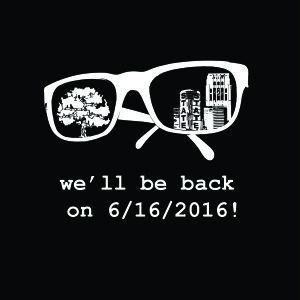
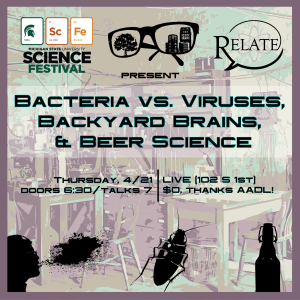 Drink an enlightening brew while you discover bacteria battles and cockroach control at this month’s Nerd Nite Ann Arbor! Come by to hear Ada Hagan tell of the zombie apocalypse that occurs when a certain virus attacks bacteria. Dylan Miller will explain how to take over someone’s free will with DIY neuroscience. And Ryan Engemann will explain scientific development through beer while you order another pint. We are excited to be partnering with the Michigan State University Science Festival this month, so come check out the awesome speakers we’ve got lined up to school you this time.
Drink an enlightening brew while you discover bacteria battles and cockroach control at this month’s Nerd Nite Ann Arbor! Come by to hear Ada Hagan tell of the zombie apocalypse that occurs when a certain virus attacks bacteria. Dylan Miller will explain how to take over someone’s free will with DIY neuroscience. And Ryan Engemann will explain scientific development through beer while you order another pint. We are excited to be partnering with the Michigan State University Science Festival this month, so come check out the awesome speakers we’ve got lined up to school you this time.
When: Thursday, April 21, 2016, doors at 6:30 pm, talks at 7 pm!
Where: LIVE, 102 S First St, Ann Arbor
$$$: NO COVER! cuz Ann Arbor District Library said so
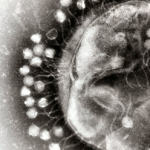 Ada Hagan – Predator vs. Prey: A Micro Tail
Ada Hagan – Predator vs. Prey: A Micro Tail
Bacteria are feared by humans for their ability to cause diseases that can’t always be treated with antibiotics. But do bacteria have a predator of their own? Come learn about the virus that uses its “tail” to prey on bacteria, turning them into zombies. Predator versus prey may be a familiar story, but hear it with some new “micro” characters.
About Ada: Ada Hagan is a doctoral student at the University of Michigan in the department of Microbiology and Immunology. She does recon on the sneaky ways bacteria find nutrients (like iron!) when they are invading our bodies. Ada is a co-founder of the graduate student science communication blog MiSciWriters. Originally hailing from the mountains of East Tennessee, Ada spends her spare time writing, walking her dogs, cooking, and comparing strollers. Follow her on Twitter @adahagan.
 Dylan Miller – The Body’s Electricity: From Cockroaches to You!
Dylan Miller – The Body’s Electricity: From Cockroaches to You!
Have you ever had the desire to lose your free will? Or, alternatively, have you ever had the desire to take someone’s free will? This talk will discuss how Backyard Brains uses DIY-style neuroscience to bring to you direct control, via your muscle electricity, over cockroaches, machines, and even other humans!
About Dylan: Dylan Miller came to Backyard Brains as an undergraduate in neuroscience. He has since graduated from Michigan State University, and now works at BYB as a research scientist and on marketing. He initially joined in order to apply the RoboRoach setup to controlling scorpions, and moved on to manage several other undergraduate DIY-neuroscience projects. He also studies the behavior of scorpions in a separate research lab at MSU. Follow him on Twitter @BraconidaeBaron.
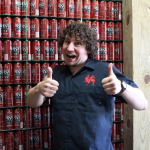 Ryan Engemann – The Science of Beer
Ryan Engemann – The Science of Beer
Beer has been there from the beginning of the scientific revolution. From providing sanitary nourishment to the development of modern medicine and pasteurization, beer has been an integral influence on the development of science. Join Certified Cicerone® Ryan Engemann and explore this fascinating topic–over a pint, of course.
About Ryan: A nerd by nature, Ryan started working in the craft beer industry in Northern Michigan in 2011. He became the first Certified Cicerone in Northern Michigan and now can be found selling beers and talking science at Brewery Vivant in Grand Rapids. Check out what the brewery is up to on Facebook, Instagram or Twitter @breweryvivant.

We’ve got a special WEDNESDAY edition of NNA2 headed your way this March! Monica Dus will reveal the secret of why that sugar-free cookie just ain’t the same as the real thing. Lindsay Blackwell will explain the difference between harmless and super-scary trolls on the interwebs. And Brian Worthman will take us on a journey by describing how smarty-pants scientists figured out the makeup of the Earth’s crust. Three of the greatest nerds that A2 has to offer, awesome friends, and booze to boot? Get down to LIVE to geek out with us!
When: WEDNESDAY, March 16, 2016, doors at 6:30 pm, talks at 7 pm!
Where: LIVE, 102 S First St, Ann Arbor
$$$: NO COVER! bc Ann Arbor District Library RULEZ the SCHOOLZ!!
Monica Dus: “50 Shades of Sweet: How Sugar Dominates the Brain”
We like to think we can resist life’s temptations, but ever tried saying no to a cookie?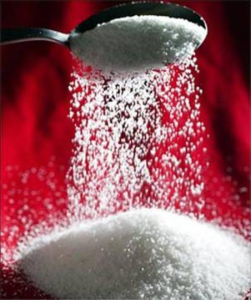 It whispers to you, it calls to you. Sugar is a powerful force: it hijacks your brain and wins nearly all the time … I’ll talk about how this happens and also how, even if your mouth is fooled by fake sugar, your brain is not.
It whispers to you, it calls to you. Sugar is a powerful force: it hijacks your brain and wins nearly all the time … I’ll talk about how this happens and also how, even if your mouth is fooled by fake sugar, your brain is not.
About Monica: I got my first microscope at age 7 and had an idyllic childhood in Italy pulling hair off Barbies and legs off bugs and looking at them under the microscope. What really drew me to science, however, was the pervasive beauty of the natural world. I still remember my first encounters with molecular biology: I was awed by its beauty and complexity. Nearly twenty years later, I still haven’t found something that is man-made and more beautiful than the natural world, not even a Dolce&Gabbana dress. I am currently a professor at University of Michigan where I head a research lab and teach genetics and neuroscience. My favorite things in life are dogs, desserts, philosophy and post-modern literature, pastel colors, unicorns, and of course, teaching.
Find her on Twitter as @Hardkandy000
Lindsay Blackwell: “Trolls, Trouble, and Telling the Difference”
 For as long as we’ve had the Internet, we’ve had online trolls. But what is a troll, really—and how do we tell the difference between trolling and more serious forms of abuse? To build a better and more empathetic web, researchers, designers, and users must work in tandem. In this talk, PhD student Lindsay Blackwell explores the ins and outs of misbehavior online, including efforts to regulate and prevent online harassment.
For as long as we’ve had the Internet, we’ve had online trolls. But what is a troll, really—and how do we tell the difference between trolling and more serious forms of abuse? To build a better and more empathetic web, researchers, designers, and users must work in tandem. In this talk, PhD student Lindsay Blackwell explores the ins and outs of misbehavior online, including efforts to regulate and prevent online harassment.
About Lindsay: Lindsay Blackwell is a PhD student at the University of Michigan School of Information’s Social Media Research Lab. Her research explores misbehavior in online communities, including trolling and online harassment. Prior to graduate school, Lindsay enjoyed a career in social media marketing, where she won several awards for her work with clients like I Love New York. You can follow Lindsay on Twitter (@linguangst) or by visiting www.lindsayblackwell.net.
Find her on Twitter as @linguangst
Brian Worthmann: “Journey to the Center of the Earth”
From the guy who brought you acoustic waves in the air and ocean a few Nerd Nites ago comes another talk about the inner layers of the Earth.  Many of us learned in high school (or earlier!) that the Earth is composed of a crust, mantle, outer core and inner core. But how do we know that? The easy answer is “well, smart scientists said so”. But assuming you consider that an unsatisfactory explanation, Brian will talk about some feats of science and engineering used in the last hundred years or so to explore what lies beneath our feet.
Many of us learned in high school (or earlier!) that the Earth is composed of a crust, mantle, outer core and inner core. But how do we know that? The easy answer is “well, smart scientists said so”. But assuming you consider that an unsatisfactory explanation, Brian will talk about some feats of science and engineering used in the last hundred years or so to explore what lies beneath our feet.
About Brian: A graduate student at the University of Michigan in the Applied Physics Department, Brian spends his not-free time researching acoustics and talking about science with whoever wants to listen. And he spends his free time nerding out pretty hard about physics, math and engineering, and binge-watching House of Cards Season 4. Brian is a 2015 RELATE alum, and also one of the newest members of the RELATE coordinator team.
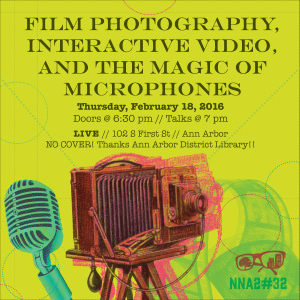
It’s Media Mania Month at Nerd Nite Ann Arbor! We’re focusing in on the life after “the death of film” by exploring the process behind and the art created with non-digital photography with historic camera expert Ross Orr. We’ll hear from Martin Thoburn, an interactive filmmaker who finds endless ways to expand his video-based art beyond the screen. Andy Ross might know more about microphones than any person to ever speak into ours – and he’ll be telling the story of the impact of mic amplification on modern music. Join us for a deep dive into audiovisual awareness, plus drinks, laughs, and a spin on a vintage 35MM Carousel projector.
When: Thursday, February 18, 2016, doors at 6:30 pm, talks at 7 pm!
Where: LIVE, 102 S First St, Ann Arbor
$$$: NO COVER! Courtesy of the Ann Arbor District Library!!
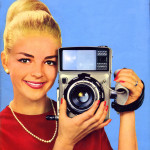 Ross Orr – Are Film Cameras Dead, and Why Not?
Ross Orr – Are Film Cameras Dead, and Why Not?“Didn’t Kodak go bankrupt?” After the year 2000, sales of photographic film plunged by at least 95%. Yet there’s still a dedicated fringe who appreciate film’s tangible physicality and distinctive look. In a digital age, why are new converts dusting off decades-old, chunky, glass & metal cameras? For this talk we’ll bust out the 35mm Carousel projector and look at examples of why “slow photography” matters even today.
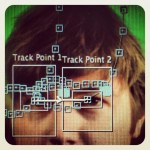 Martin Thoburn – Beyond the Video Frame
Martin Thoburn – Beyond the Video FrameTake a walk beyond traditional filmmaking and into the world of interactive video art and video mapping. Our journey will go behind the scenes on how this artist’s projects were created from concept to execution. Discover more about the strange world of video beyond the rectangular screen.
About Martin: Martin is a local animator and artist working in a variety of different media. He has produced and directed several short films, both animated and live action. Determined not to be confined to any one medium, Martin continually explores photography, live video mixing, design, collage, animation and motion graphics. Working with both modern and antique technologies sometimes in tandem, his work explores the uniqueness of the medium, technology, and/or tool. He is involved with YPSI24 and the Ann Arbor Film Festival and you can follow him on Twitter @duiceburger, or visit
martin-thoburn.com.
 Andy Ross – Music and The Microphone
Andy Ross – Music and The MicrophoneThe invention of the microphone dramatically changed popular music, and allowed for the development of a more personal, intimate and emotional style of singing. We’ll look at, and listen to, this development.
About Andy: Andy is a web and graphic designer, and a widely exhibited artist here in Ann Arbor. He’s also a dedicated amateur musician and singer, and he has taught courses in popular culture and its impact. Find more about him at
andyrossdesign.com or follow him on Twitter @andyrossdesign.

































